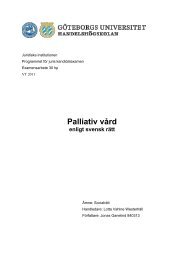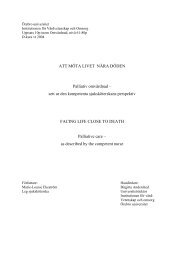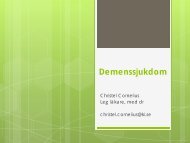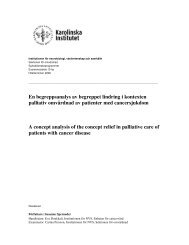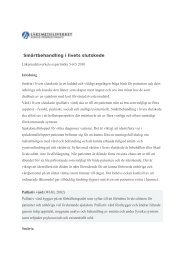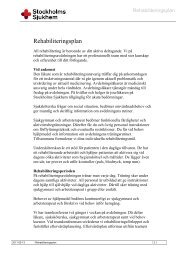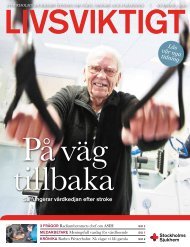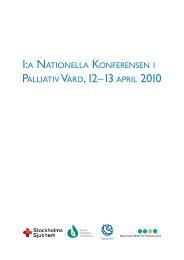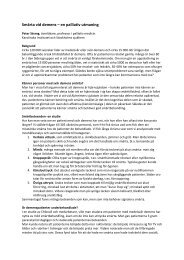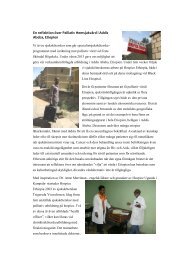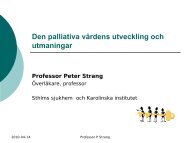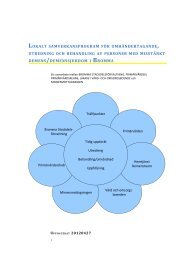Physiotherapy in palliative careâ - Stockholms sjukhem
Physiotherapy in palliative careâ - Stockholms sjukhem
Physiotherapy in palliative careâ - Stockholms sjukhem
Create successful ePaper yourself
Turn your PDF publications into a flip-book with our unique Google optimized e-Paper software.
Treatment:Give <strong>in</strong>structions for useful sitt<strong>in</strong>g positions and movements so that they are made with as littleeffort as possible. Aids such as a walker, other gait aids or wheel chair are facilitat<strong>in</strong>g. Give<strong>in</strong>structions <strong>in</strong> resistance, blow through closed lip breath<strong>in</strong>g. Another option is that the patientcan blow <strong>in</strong> a hose - 1cm <strong>in</strong> diameter - <strong>in</strong> a bottle filled with water that makes light resistance.A so called BA-tube and breath<strong>in</strong>g tra<strong>in</strong>er can also be of help.Breath<strong>in</strong>g exercises are very important, ord<strong>in</strong>ary deep breath<strong>in</strong>g where the patient is encouragedto, if possible, <strong>in</strong>hale through the nose and exhale through the mouth. Breath<strong>in</strong>g is exercisedthrough mak<strong>in</strong>g the patient observant of the synchronized movements of the abdomen whenbreath<strong>in</strong>g by e.g. putt<strong>in</strong>g a hand on the stomach. This can be comb<strong>in</strong>ed with closed lipbreath<strong>in</strong>g. If the patient has phlegm use cough<strong>in</strong>g support. Give <strong>in</strong>structions about the huff<strong>in</strong>gtechnique if the patient has difficulty cough<strong>in</strong>g.The physiotherapist can <strong>in</strong>struct the <strong>in</strong>halation technique when us<strong>in</strong>g nebuliz<strong>in</strong>g equipmentwhen the patient needs to <strong>in</strong>hale medication or natrium clorid solution. To stress therelationship between muscle tension and breath<strong>in</strong>g, exercises for the shoulder and chest arecarried out. Massage of the shoulders and neck can reduce anxiety.For patients <strong>in</strong> a later <strong>palliative</strong> phase of the disease, where breath<strong>in</strong>g exercises can be tootir<strong>in</strong>g, <strong>in</strong>structions on rest<strong>in</strong>g positions can be more relevant. Different rest<strong>in</strong>g positions give arelaxation of the muscles that can facilitate breath<strong>in</strong>g and lessen dyspnoea and anxiety. It isimportant to give <strong>in</strong>formation also to the family to create calmness, comfort and well-be<strong>in</strong>g forthe patient.Most of the studies have been carried out on COPD-patients, some studies were carried out onpatients with an advanced cancer disease. There is reasonably strong evidence for breath<strong>in</strong>gexercises and us<strong>in</strong>g walk<strong>in</strong>g aids to m<strong>in</strong>imize the efforts (41).NauseaWith an advanced cancer disease 40 – 70 % of the patients are troubled by nausea and vomit<strong>in</strong>g.(5) These symptoms can be triggered by different causes. The cancer disease can causeileus/subileus and so can metastases <strong>in</strong> the liver and bra<strong>in</strong> which can cause nausea andvomit<strong>in</strong>g. Treatment with chemotherapy, radiation and other medication and former abdom<strong>in</strong>alsurgery can cause nausea and vomit<strong>in</strong>g. Nausea can be triggered by mov<strong>in</strong>g as well as bysymptoms like anxiety, constipation and pa<strong>in</strong>. (25)<strong>Physiotherapy</strong> <strong>in</strong> <strong>palliative</strong> care – a cl<strong>in</strong>ical handbook Ulla Frymark, Lilian Hallgren, Ann‐Charlotte Reisberg 27



